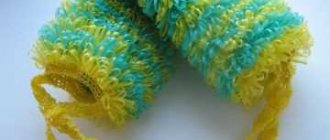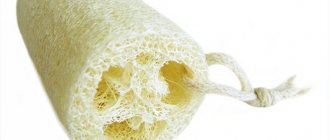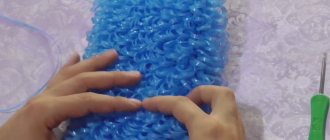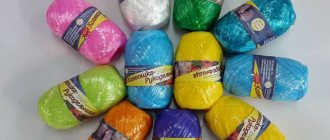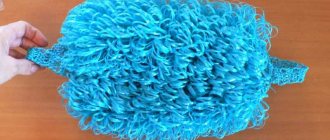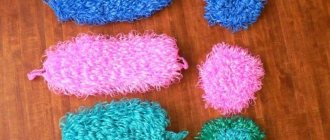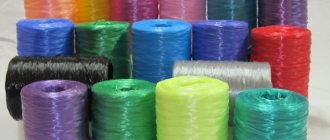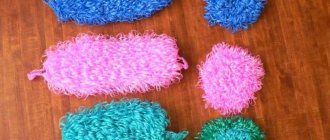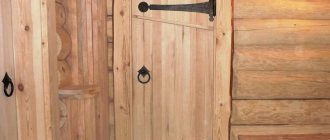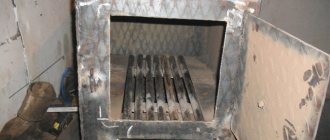Not all hand-knitted items are clothing items. You can also tie a washcloth for bathing. After all, yarn can be made not only from wool or cotton, but also from polypropylene, products from which are easy to lather and scrub off the dead skin layers well, and then wash and dry quickly. It is pleasant to wash with such a washcloth.
We will tell you how to crochet a washcloth in a variety of shapes - classic rectangular, mitten-shaped or in the form of various toys filled with foam rubber. Children will find such bathing especially enjoyable, and adults will enjoy using handmade products that are much better than store-bought washcloths.
Durable washcloth
No holes are formed in the proposed washcloth; its loops hold firmly without moving apart. The washcloth is crocheted from special threads for washcloths using crochet number 2 into one thread. The washcloth is knitted on both sides, in the round, for which 30-40 air loops are cast. The width of the washcloth depends on their number. The synthetic thread resembles polypropylene tape, but this does not interfere with crocheting at all.
Having typed the specified number of loops, we connect them into a ring with a connecting post. The next 4-5 rows are knitted with single crochet or single crochet; no pulled loops are formed on these rows. Then comes the turn of the rows with these loops, knitted in such a way that they cannot stretch and disrupt the configuration of the product.
Yarn for washcloths
Both natural and artificial materials can be used for knitting washcloths. Natural washcloths are healthier, but they last much less, since they contain pathogenic organisms and can rot and mold. Their maximum service life is 1 month, after which the washcloth should be replaced with a new one.
Washcloths made from synthetic threads last much longer; it is recommended to use them for no more than 3 months, although their strength can be maintained for more than a year:
- Cotton and linen. Cotton washcloths are soft and suitable for children and people with very delicate and sensitive skin or those suffering from skin diseases. Linen washcloths have a beneficial effect on blood circulation.
- Polypropylene. It is considered a fairly strong synthetic material. Washcloths made from such threads lather well and are able to perfectly remove sweat, fat and dead skin cells.
- Leg-split. Polypropylene twine, which is very durable, is more suitable for washcloths. But natural ones are also suitable: jute or linen.
- Sisal. Obtained from the leaves of Agave sisalana. This material is more suitable for flat massage sponges that work well on rough skin.
- Plastic bags. Knitting washcloths from this material is considered a utilitarian craft that is beneficial and helps to get rid of unnecessary things. Washcloths knitted from bags are suitable for people with delicate and sensitive skin. It is not recommended to use them when using scrubs.
- Nylon tights. Fragile women's products quickly break down and have to be replaced frequently. Needlewomen do not throw them away, but use them for knitting washcloths, cutting them into strips 3-4 cm wide. It is better if the washcloths made from tights are flat.
- Sock additive. The material is quite durable, suitable for any washcloths, even those intended for washing dishes.
- Viscose. Washcloths made from artificial fiber, which is made from pine or bamboo wood, are quite durable and beautiful.
- Acrylic. Sponges made of acrylic, a synthetic polymer fiber made from petroleum products, are very durable and reliable.
- Bags. If you don’t have yarn on hand, you can unravel the used bag. Pre-washed sugar and flour bags are suitable. The washcloth will be durable and beautiful.
Crochet hooks are selected according to the threads used. It is desirable that they have rounded rather than pointed heads.
Ready washcloths 10 min. should be kept in boiling water. They will become more pleasant and lather better.
What material to use
You can purchase both natural and artificial threads. Materials of natural origin will make the grater a little more useful, but such things do not have a long service life.
Threads are sold in any market, so purchasing them is not a difficult task. You have to choose from the following fabrics:This is interesting: things knitted from synthetic thread have an impressive service life, up to one year.
How to crochet hard and soft
Crocheting a washcloth can be difficult for beginners, but step-by-step instructions will help you get the job done. The main thing is the ability to knit a lush column.
For a double-sided washcloth, a No. 4 hook and any polypropylene yarn are suitable. The future washcloth can be either plain or beautiful multi-colored.
The sides turn out to be different - one is hard, knitted lengthwise, and the other soft, knitted across:
- 1st step – chain. The length of the future washcloth will depend on the number of loops cast on.
- The 1st and 2nd rows consist of sc.
- 3rd row. If the washcloth is multi-colored, then first an air loop is knitted with 2 threads, followed by 2 sc, then a fluffy stitch. It is untied from the originally knitted chain.
To form a fluffy column, you should knit 5 dc and secure them with an air loop. Next come 3 sc and knitting the next lush column. This continues until the row ends.
- 4 row. The first loop is knitted with an air loop, then the sc is knitted into the loops of the previous row. For a multi-colored washcloth, the last loop is knitted with 2 threads at once.
- The 5th row is knitted again with a thread of the first color, chain stitch as well. Next comes the alternation of 3 sc and a lush column, which is knitted from the loop of the last knitted row of the same color.
- Row 6 is knitted like row 4.
- 7th row. If the washcloth is knitted in different colors, a thread of the third color is introduced into the work and row 5 is repeated.
- Row 8 is similar to row 4.
- Continue knitting until the required width of the washcloth is reached.
To knit the soft side, you need to start working from the side of the resulting fabric. This side is knitted in the same way as the previous one, but the fluffy stitches are made from three dcs, not five. And they will alternate not with 3 sc, but with 2. Having finished the 2nd side, both halves are folded and either crocheted around the perimeter or sewn from the inside out. At the request of the knitter.
If the halves were sewn together, then the result is a pipe and the holes still need to be crocheted and then the handles are tied. You can sew cotton braid as handles. To make it soft, scald the washcloth with boiling water.
Loofah – ball with filler
Crocheting a washcloth can also be in the form of a ball. This is a very interesting option for those who love unusual and environmentally friendly things.
First we crochet the ball.
3 v.p. connect in a circle.
1 row. 1 v.p. rise (in each row) and 6 tbsp in this circle. Finish with a connecting loop in v.p. lifting (in each row).
2nd row. 2 st.b/n in each st.b/n of the previous row.
3rd row. St.b/n + 2 st.b/n. Alternate dc and 2 dc until the end of the row.
4 row. St.b/n, st.b/ + 2 st.b/n. Alternate according to the st.b/n, st.b/n + 2 tbsp.b/n
5 row. First, 3 times tbsp + 2 tbsp.
6th row. 4 times tbsp./n + 2 tbsp.b/n.
Knit in this way until you alternate 10 tbsp and 2 tbsp in the next stitch.
Then knit 20 rows according to the pattern, without adding single crochets. I changed the yarn in the middle of the wash ball.
Now let's make the ball smaller.
1 row. 10 tbsp, decrease (skip one tbsp).
2nd row. 9 st.b/n + decrease.
Knit this way, leaving a small hole for filling.
How to fill a bulky washcloth with a hook:
- Dry herbs. You can use mint, lavender, etc. Ideal for a bath.
- Hay. It will sting a little, but this has its own charm - the effect of a scrub for rough skin particles.
- Buckwheat husk. Massage effect and anti-cellulite prevention.
- Sintepon. Soft and voluminous. Suitable for those who love foam.
- cotton wool
On a note. A sponge ball with filler will take longer to dry than a regular one. Therefore, after use it is better to put it on the battery.
After this, tie the remaining rows of the ball, evenly distributing the filler. Make a loop.
With extended loops
Beginner knitters should start with a flat washcloth, which will have elongated stitches on only one side. Due to these loops it will turn out to be more voluminous. They can be in every row, after 1, or even after 2 rows. In order to save yarn, the loops can be diluted with single crochets.
A crocheted washcloth for beginners (step-by-step instructions help you understand the sequence of work) of the volumetric type is more complex, but the proposed drawings will help you master it too.
For a voluminous washcloth in the form of a hollow pipe, you will need about 300 m of polypropylene and a hook No. 3. Like most washcloths, knitting begins by closing air loops into a ring (there should be 40 of them here).
Since it is knitted in the round, the transition to the next row is carried out through air loops that form a rise. Do the same when knitting other washcloths.
7-8 rows (more or less possible) are knitted. Dc is also possible. Then comes the knitting of the elongated loops (the knitting technique is shown in the pictures below). Loops can remain both in front of the work and behind it. The elongated loops are knitted to the desired length. The work ends with the same number of rows of sc (or dc) as it began.
|
To knit handles, 30-40 air loops are made, preferably in 2 threads. The height of the loops can be made very different; the volume and “fluffiness” of the future washcloth depends on it.
How to choose threads
The best yarn for washcloths is single- or double-twisted polypropylene, but threads that are natural in composition are even more valued. The yarn should be strong and smooth. The thicker the thread, the stronger the product.
- Jute. Eco-friendly washcloths are knitted from it. Jute yarn is made from the fibers of an annual plant grown in India and Egypt. A jute washcloth is moderately hard, it absorbs water well and lathers up. Daily exposure of jute to the skin stimulates blood circulation and improves metabolic processes in the dermis.
- Hemp. Yarn made from hemp stem fibers. Its properties are similar to flax, but at the same time more durable and lighter. Products made from it do not lose their shape and do not stretch when exposed to moisture.
- Lyko. It is made from linden or willow wood fibers. These washcloths are suitable for sensitive skin.
- Loofah. Yarn made from grass fibers. Its effect on the skin is difficult to overestimate: pore cleansing, anti-cellulite massage, cell regeneration. At the same time, such a washcloth turns out to be very tough. The loofah holds its shape well, quickly soaks in water and lathers well.
- Sisal. Agave fiber. Like any natural yarn, it has a beneficial effect on the condition of the skin, but due to its increased rigidity, it is recommended to use this accessory no more than twice a week. The disadvantage of sisal is that it takes a long time to dry.
- Linen. The most delicate material, suitable for baby washcloths, but before use, such an accessory must be steamed with hot water.
- Cotton. Most often it is used for washcloths for babies. Such products are short-lived, but cotton is best suited for children's skin.
- Capron. Such threads are usually thin, so they are knitted in several layers. The products are durable, but tend to stretch.
- Polyethylene. For knitting, it is better to use industrially produced yarn, but experienced craftswomen can also indulge in creativity using homemade “threads” from ordinary plastic bags. The advantage of such washcloths is moderate rigidity and durability. The downside is poor absorption and the possibility of skin allergies.
Double crochets
Almost when knitting any washcloth, you will encounter double crochets.
A very simple washcloth can be made using only them. You will need synthetic twine, hook number 3, acrylic or viscose.
It is recommended to knit in 2 threads. The washcloth will be quite hard.
Knitting step by step:
- From the collected 40 air loops, dc are knitted.
- Knitting proceeds in a spiral to the required width.
- On turns, 3 dc are knitted into one loop, this will help avoid pulling.
- The outer row is knitted in the opposite direction. Having knitted one of the sides, a chain for the handle is knitted, then knitting goes on the other side and ends with knitting the second handle.
- After attaching the handle, the thread is cut and secured.
Video lesson:
Single layer washcloth
When knitting this washcloth, elongated loops are knitted on both sides. To obtain a more fluffy washcloth, knitting was carried out in two threads. That is, two skeins are used or one, then the second end is additionally pulled from the inside. After casting on an air row of loops, a row of stitches with one crochet is knitted.
The next row is knitted without double crochet. After the third row, we begin knitting with elongated loops, forming them with the thumb. In the last stitch of the row, a single crochet stitch is knitted. After turning the work over, the next row is knitted with similar elongated loops, and they end up on the opposite side of the product.
With a "bump" pattern
To knit such a beautiful washcloth, you should prepare hook No. 5, with which you first knit a chain of 36 loops, which is subsequently closed into a ring.
Knitting step by step:
- The 1st row is knitted with single crochets.
- 2-4th rows: double crochets, but already double crochet.
- The details of the main pattern - the bumps - are knitted to the length required. To form a cone, 3 yarn overs are formed, which then need to be knitted together. 2 columns are skipped, and another bump is formed.
- The bumps on the washcloth should have a checkerboard pattern.
- Knitting in the round. They finish it as they started: rows 1-4 are knitted in the reverse order.
- The handles can be knitted separately and then attached, or you can start knitting with one handle and finish the product by knitting the other.
Video lesson:
Crocheted washcloth
This master class is designed for those who do not know how to knit at all. The training begins with a story about how to properly hold the hook, ensuring its movement. The initial loops are also described in detail. The result is a chain of air loops, connected by a ring that serves as a cuff for the product. A row of single crochets is formed; five rows is enough.
In the next rows, elongated loops begin to form, which are draped over the thumb. The technique for creating these loops is discussed in detail on the screen. Further rows are knitted exactly the same until the washcloth reaches the specified length. You can change the color of the thread.
With a spiral pattern
A chain of 47 loops is knitted with a double thread, which is subsequently closed into a ring.
Knitting a washcloth:
- 1st row. Single crochets are knitted into each loop of the chain.
- The 2nd, and all subsequent rows, are knitted with already elongated loops, knitted into each column. After knitting 6 loops, a thread of another color is introduced into the work, and 6 loops are knitted again. The next 6 stitches are knitted again in the first color. And until the end of the row there is an alternation of different colors.
- In each row there is a color shift by 1 stitch. The length of the washcloth can be any. The knitting ends with a row of double crochets.
You can make all the stripes different colors, the width of the stripes can also change.
Video lesson:
Bathing sponge
The thread that is used to create the washcloth is specifically designed for creating washcloths and rugs; it is made of polypropylene. You can choose a thread of different colors - the color range is quite wide. A carefully knitted washcloth is much more durable than a store-bought one. First of all, a chain of air loops is assembled, twice as long as the width of the future washcloth. You need to knit carefully, not allowing the thread to delaminate.
The edges of the chain are connected to each other, and a handle is immediately knitted for holding a washcloth, made of 3-4 stitches. Everything is told step by step for beginners, all actions are described in detail. After several regular rows, rows with elongated loops are knitted, which are tied around the thumb.
Children's washcloth toy
A crocheted washcloth (step-by-step instructions for beginners are presented below), crocheted in the shape of a hedgehog, will not be difficult if this pattern is used when knitting.
Knitting step by step:
- To start knitting, you should knit a chain of 32 chain stitches and connect the first and last loops.
- The first 2 rows are knitted with single crochets.
- Then 30 rows are knitted with “fur” (in the manner described above).
- To knit the muzzle you will need white. 5 rows are knitted with simple stitches, after which 4 loops should be decreased in each row.
- The thread is cut and secured. The eyes and nose are decorated with threads of the main color using a needle.
Berry-shaped washcloths also look gorgeous.
Video lesson:
Washcloth with a pattern of “Bumps”
The yarn used is double, hook number 5. First of all, 36 chain stitches are cast on, they are connected with a ring, and a row is knitted in single crochets. In the next row, only single crochet stitches are used, then two more similar rows are knitted. Let's start creating the main pattern.
A cone is formed from three yarn overs knitted together. Two stitches are skipped, and another cone of four yarn overs is knitted. The entire row is formed from such cones. This pattern with cones is repeated from row to row. A washcloth made of cones arranged in a checkerboard pattern ends with a cuff made of rows of single crochets.
In the form of a ball
A crocheted washcloth (for beginners, step-by-step instructions may only be required at the beginning of knitting) in the form of a ball can be made in a short period, since it has a small amount of work.
To make the diameter of the finished washcloth 11 cm, you need to take 50 g of cotton yarn and a hook number 4.
The spherical shape is obtained by knitting several stitches into one loop. In this case, natural folds are formed.
The execution begins with knitting 5 air loops, which are subsequently closed into a small ring.
Another closed chain consisting of 40 loops is useful so that the washcloth can be hung to dry.
All circular rows begin with lifting using air loops (this method is described above).
The single crochet is replaced with one air loop. To replace the double crochet, knit 3 chain stitches. End the rows with a connecting loop.
Step by step knitting:
- 1st row: in a small (five-loop) ring you need to knit 18 single crochets.
- 2nd and 3rd rows: in each of the knitted loops of the previous row you need to knit 3 single crochets.
- As a result, after the 2nd row there should be 54, after the 3rd – 162 loops.
- The 4th row is completely knitted with single crochets.
You can get a more voluminous washcloth by replacing simple stitches with stitches with 1 or 2 crochets.
Why should you pay attention to this type of needlework?
A product made independently is much cheaper than similar ones on sale. You only pay for materials. You can also choose the color and design of the washcloth yourself. Among the variety of materials, you will find exactly the one that suits you.
This article will discuss techniques for knitting washcloths for beginners and provide step-by-step instructions for knitting a washcloth. You will also learn such an interesting technique as knitting a washcloth in loops.
From plastic bags
A large selection of multi-colored plastic bags, different in texture, is used for knitting washcloths. You can take already used ones, or you can buy new ones. It is better to choose softer ones that do not have handles or ties.
You can choose any shape of washcloths. The main thing is to properly prepare yarn from them.
| The bag must be folded several times to one side, leaving approximately 2.5 cm. | |
| The folded part of the package is cut into strips 2.5-3 cm wide, not cutting completely. | |
| The strips are straightened in length. | |
| Then the uncut part is straightened out and the strips are cut diagonally. The cuts go from the cut of the 1st strip to the 2nd, from the cut of the 2nd strip to the 3rd and so on. | |
| It should turn out like this. | |
| The arrow shows the seam of the bag. |
Next, the strips are wound into balls and you can start working. For a washcloth, the size of which is 70*15 cm, approximately 30 medium bags are required. You can knit in any way; you can add elongated loops for strength and looseness.
Massage washcloth made from strips of fabric
For this washcloth, you can use strips of fabric cut from old tights or any old synthetic items. It's better if it's at least two different colors. This knitting is best done with large knitting needles, approximately No. 7.
Master Class
Cut ribbons of fabric and roll it into a ball. Cast on with knitting needles 11 stitches. and knit 8p. garter stitch.
Change the color of the threads and knit 10 rubles. shawl pattern. Then we knit 28 rubles with light yarn. We change the color twice more: 10 rubles. light, 8 rub. – dark. Close the loops by knitting 2 stitches. in 1p.
At the end of the washcloth, tie three strips of fabric and weave them into a braid 35 cm long. At the other end, make the same braid.
For dish washing
A crocheted washcloth (for beginners, step-by-step instructions will help you complete the product correctly) for washing dishes will require stocking up on 20 g of synthetic yarn and hooks No. 4 and No. 5.
| 21 loops are cast on with hook No. 5. You need to leave a tail for later stitching. | |
| All rows are worked sc. The difference is that in the front rows they are performed on the back wall of the loops, and on the back rows on the front wall. In the 1st row, 2 sc are performed in the second loop. | |
| Sc are worked into every stitch except the last 2. | |
| The hook must be inserted into both remaining loops at once and the working thread is pulled through them, then one of the 2 loops is knitted. | |
| Next, an air loop is knitted for lifting. There should be 20 loops in the work. | |
| After turning the work, row 2 is knitted (purl). The hook is inserted immediately into the first 2 loops, which are knitted in the manner described above, sc. | |
| Next, a sc is knitted from each loop. There is no need to knit the last loop. | |
| 2 sc are knitted from the remaining loop. And then an air loop for lifting. | |
| Row 3 is knitted like row 1. From the last 2 loops, 1 sc is performed. | |
| The 4th row is knitted like the 2nd row. | |
| When knitting a plain washcloth, rows 1 and 2 alternate. In total you need to knit 21 rows. If the washcloth is planned to be two-color, then the colors alternate through any number of rows (optional). When changing color, the air loop for lifting is knitted in a new color. The last strip needs to be knitted 1 row more, this is for sewing the product. | |
| A total of 21 rows are connected. It turns out to be a parallelogram. | |
| The product is folded so that the threads from the beginning and end of knitting are together. This creates a hollow tube. | |
| Now you need to connect the product. This is done using the thread left at the beginning of knitting. A hook of a smaller diameter will be useful for this. | |
| The seam is best done from the inside out. Then turn the product inside out. | |
| All that remains is to tighten the holes, like tightening the crown of a hat. This can be done using a running stitch along the edges of the holes. | |
| The product is flattened, the center is secured by tightening and tying together the threads that were used to sew the holes. | |
| View of the washcloth from the other side. | |
| From the remaining threads you can knit a loop for hanging. You can leave the washcloth in a rectangular shape, then the top and bottom are crocheted with sc. A multi-colored washcloth looks beautiful. |
Ergonomic knitted washcloth
To knit a washcloth with knitting needles, you should arm yourself with:
The process of creating a bath masterpiece consists of the following stages:
- loops are cast on - 32 pcs. (8 pieces for each knitting needle);
- knit 3-4 rows with knit stitches;
- a transition is made to the pattern - a row with elongated loops alternates with rows with facial loops;
- knit 3-4 rows with knit stitches - complete the work;
- handles are made - loops are gathered from the edge of the washcloth, a “rope” is knitted and fixed on the other side of the accessory (ribbons can be sewn on).
A convenient accessory is ready! And to make it exclusive, you can use multi-colored yarn.
If any difficulties arise, watch the master classes. But, as practice shows, tying a “gift” accessory correctly is not difficult!
An anecdote on the topic: A cat’s tongue is not only a tongue, but also a spoon, a mug, a toothbrush, a fur brush, soap, a washcloth and toilet paper!
So, charming needlewomen, as you can see, the devil is not as scary as he is painted. How to learn to knit a bath accessory? It's simple! Take and knit! But seriously, you need to read articles, watch master classes, arm yourself with the necessary materials (knitting needles, hooks, yarn), be patient and invite the Muse to visit. That's all the secrets!
Good luck to you, lovely craftswomen! And peace to your home! Bye!
Wisdom Quote: Teach and learn the best (Thales).
Some information was borrowed from the portal: https://www.diy.ru/post/3897/
A washcloth is an absolutely necessary thing in everyday life. Smooth, fluffy, for the bath, for washing dishes - not a single housewife can do without them. Moreover, it is absolutely not necessary to spend money on them. We will show you how to knit a washcloth with knitting needles with your own hands. To do this, you will need threads (preferably synthetic, such as polypropylene) and a set of sock knitting needles.
Mitten - washcloth
For knitting creative washcloths, it is preferable to use natural materials. It can be cotton, sisal or linen. Synthetic yarn will also work.
Step by step knitting:
- You should start with a chain, the length of which is determined by the size of your hand.
- Knitting goes in circles. Single crochets are used.
- Fabrics for fingers (or one finger) are also knitted in a circle.
- For a child, a knitted mitten is designed in the shape of some funny animal. How to do this is shown below.
If the mitten is knitted from artificial yarn, then elongated loops will look more beautiful. | |
Sponge with cones
The finished product does not have elongated loops; it will be flat, with an interesting pattern in the shape of cones. You must use double thread and a size 5 hook.
First you need to cast on 36 ch, which at the end of knitting are connected into a ring, and then knit a row in single crochet columns. Work the next row with a double crochet stitch. Do the next two rows in the same way. Then you need to start forming the main pattern.
To do this, you need to knit 3 yarn overs together, forming a bump. Then skip 2 columns and knit another cone consisting of 4 yarn overs. In this way the entire row is formed. Identical manipulations must be carried out with each new row.
When the desired size of the product is reached, it is necessary to complete the knitting process by forming a cuff from rows of sc.
Crocheting a washcloth is quite easy; even beginner needlewomen can do it. There are many detailed master classes on the Internet, thanks to which you can create real masterpieces with your own hands.
Round
Round (or oval) washcloths knitted from stiff threads are well suited for peeling. For convenience, they must have hand loops. You can take the proposed scheme as a basis. To make the washcloth look more “lush”, alternate columns with elongated loops are used.
In the 3rd round, 2 are knitted from each loop. As a result, the number of stitches will double. The 4th round is knitted without any additions. In the following circles, the methods of knitting the 3rd and 4th circles alternate.
The penultimate row: 2 dc are knitted from one loop, and one from the next. In the extreme row there is an alternation of 2 dc with 2 chain loops. The final step is knitting the handle.
To prevent the ends of synthetic threads from unraveling, they are secured with a hook, then heated using a lighter or candle. When the thread begins to melt, it is pressed against the product.
A do-it-yourself crocheted washcloth using step-by-step instructions for beginners will be an excellent addition to a gift for family and friends.
Author: Lapushechka
Article design: Natalie Podolskaya
Let's sum it up
This tutorial will help you knit a washcloth. As you may have noticed while reading, this is a fairly simple craft that can bring a lot of pleasure from the process itself.
A homemade item, enclosed in a beautiful package, will be an excellent gift option for March 8th or New Year. To truly please any woman, add shampoo, scrub or body milk to the grater. You can also knit children's washcloths-toys, with which you can surprise your kids. Good luck!
DIY birch bark washcloth
DIY birch bark washcloth
A birch bark washcloth or “birch bark” is a personal hygiene item made from natural material.
To make such a washcloth, take birch bark, cut it into strips and tie it at one end. You will get a round ball that can be used for going to the bathhouse.
You can make a birch bark washcloth with your own hands in another way:
- Take a piece of birch bark 20cm x 20cm
- In the middle of this square, mark a strip 3cm wide
- Cut the birch bark on both sides of the mark into narrow strips
- Roll the workpiece into a tube and tie it in the middle. It turned out to be an excellent washcloth for a bath
Important: Before use, the birch bark product must be steamed by holding it in boiling water for several minutes.
DIY jute washcloth
DIY jute washcloth
Jute is a natural fiber. A DIY jute washcloth is an environmentally friendly product that will perfectly exfoliate dead epidermal cells and combat skin contamination. This personal hygiene item provides an excellent peeling effect.
Important: Flat washcloths are knitted from jute, both knitted and crocheted. The pattern can be whatever you like.
How to knit a one-sided washcloth?
How to knit a one-sided washcloth?
A one-sided washcloth is the simplest model that is suitable for beginner craftswomen, despite the fact that elongated loops are used to create it. How to knit a one-sided washcloth?
Depending on the material used, a washcloth with a one-sided pattern should be knitted in one or two threads. If with one thread, then crochet the product, and with two threads - with knitting needles. Choose any knitting technique at your discretion, for example, as in the video below.
